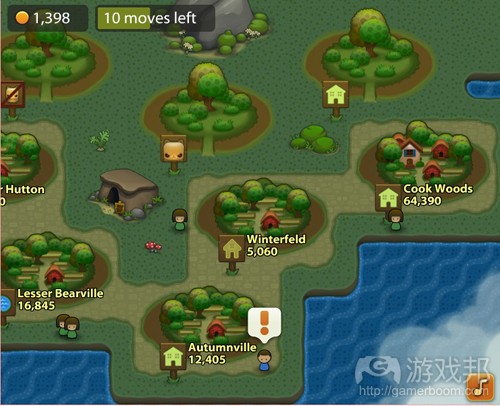Triple Town分享如何找到免费游戏设计的趣味性
作者:Patrick Miller
Spry Fox免费游戏(代表作包括《Triple Town》、《Realm of the Mad God》)获得成功的关键是什么?在日前的GDC免费游戏峰会上,该公司成员David Edery、Daniel Cook和Ryan Williams认为开发者应该关注早期原型以便完善游戏理念,制作出能够持续多年运营的在线游戏。
快速找到趣味性
Edery提到失败原型时指出,“对我们所制作的成功游戏来说,找到趣味性不应该花费太长时间——一般是几周,最多就是一两个月。我们曾花了6个月时间捣鼓原型,其实我们本该设置一个计时器,但我们却没有,因为我们对那个核心机制太着迷了。有时候过度沉迷于自己的理念才会造成最大损害。”
Cook解释道,“我们正在寻找一个能够让我们挖掘数年的核心、紧凑、健康机制。我们现在所做的就是将船开向空无一物的汪洋大海,四处寻找陆地。有时你会发现一些小岛,有时候会发现一片游戏玩法的大陆。我们将游戏视为服务,它们得长存数年之久。你需要的是能够让人们每周都投入数小时的东西,并持续数年保持它的新鲜感。我们所说的制作有趣的原型,就是指一个充满趣味的丰富世界。”
Edery称使用有助于快速创建原型的技术和工具是提高迭代速度的关键,“我们着实难以忍受那些减缓你短期目标的技术设置,我们需要每天迭代。我们不需要向那些之后才呈现出价值的技术投资,我们发现自己可以在之后需要的时候得到那些好处。所以我们一般使用Unity和Flash开发环境。”
Cook分享了他鉴定成功游戏理念的三个通用法则:势头(“游戏的趣味性是否会随着迭代而逐月增长?”,玩法空间大小(“我们如何添加内容?”),以及趣味的韧性(“你用一周时间故意让它变得很糟糕,但它却仍然不失趣味性”)。
广泛的游戏设计潜力=广泛的盈利潜力
当你通过迭代获得一个极有前景的游戏理念后,你还得看看它是否具有盈利性。Edery以《Triple Town》为例指出,“你若使用了和我们一样的流程,你可能会想出一个非常有深度和可玩性的游戏理念,但在人们玩过数百小时后,游戏却仍无法创造任何收益。这种情况在我们身上已经发生了两三次。许多人误认为《Triple Town》是一款收益大获成功的游戏,但实际上并非如此。我们的收益大概是平均每用户投入4-6美元……这款游戏的趣味来自无需花钱但却能发挥更出色的表现。一般而言,你在多人游戏中花钱是因为可以向他人炫耀你的东西/本领。”
“从这方面来看,《Triple Town》是一个浅层的游戏体验。它有一些让人着迷的优点,但这却并非驱使你花钱的原因。如果在游戏中你可以想出三四种人们会想买的东西,那就差不多了。但在《Triple Town》中,我们一开始并没有自己考虑过这个问题。”
“当我们尝试在游戏后期添加这些内容时,游戏设计已经很紧凑和功能化,因此这一措施变得毫无意义。单人游戏现在变成了我们的形象工程,我们不能指望靠它们赚钱。”
尽早发布游戏
Edery将Spry Fox一些免费游戏的成功归因于他们更愿意尽早发布游戏,而不是像竞争对手那样直到满意为止才发布产品。“将游戏展示于大批用户面前,让他们自己玩游戏,你在这个过程中可以学到更多。比起竞争对手,我们发布游戏的时间会提前6个月到1年左右,我们会首先在加拿大发布游戏。”
美术风格最后定型
在快速创建原型阶段并不适合过早在游戏理念中投入情感——过早引进制作精良的美术资产就难以保持游戏变化的弹性。Cook称“你看到美术内容,就会以为这就是游戏未来的方向。但这并不是很可行,这可能会破坏整个创建原型的过程。美术人员要定期制作许多很棒的内容,我们则在制定许多流程。但我们每天在思考的时候都会面临一个选择‘因为这些美术资产看起来太漂亮了,所以我们得讨论怎么让它们派上用场’,结果就会出现一个艰难、累垮人的数学运算和抽象结构的游戏设计。并且每回这两者对接时,美术都会胜出一筹。美术创造的是情感投入,而在原型阶段你并不需要这些。我们现在就是以粗糙的方式创建原型,并且认为如果原型在很粗糙的时候都会有趣,它之后添加情感元素时就会更有趣。”(本文为游戏邦/gamerboom.com编译,拒绝任何不保留版权的转载,如需转载请联系:游戏邦)
Triple Town devs on finding the fun in free-to-play game design
By Patrick Miller
What’s the key to Spry Fox’s (Triple Town, Realm of the Mad God) free-to-play success? In a session from GDC’s free-to-play summit today, David Edery, Daniel Cook, and Ryan Williams suggested that devs need to focus on prototyping early and often in order to refine ideas that can yield online games that will last for years.
Finding the fun — quickly
“Finding the fun, for the successful games that we’ve made, historically doesn’t take very long — a few weeks, a month, two months tops,” said Edery while discussing a failed prototype. “We spent six months banging our heads against a wall even though the warning sides were there. We should have set a timer, but we didn’t, because we were so enamored with the [core mechanic]. Falling in love with your ideas can definitely hurt you the most.”
Cook explained: “We’re looking for a core, tight, robust mechanic that we can explore for years and years on end. What we’re doing is we’re sending ships out into an empty ocean, looking for land. Sometimes you find a little island, and sometimes you find a giant continent of gameplay. We’re making games as services, and they have to last for years. What you need is something that people can engage in for hours every week, for years on end, and keep it fresh and changing as it goes. So when we say you have to prototype until is fun, what we want is this rich, robust world of fun.”
Working with tech and tools that facilitate rapid prototyping is key to their iteration speed, Edery said. “We tend to be highly intolerant of any terms of tech setup that slows down your short-term. We need to be iterating on a daily basis. We don’t need to invest in tech that will pay off later on; we’ve found that we can get those benefits later on when we need it. So we usually work in environments like Unity and Flash. It does not take an amazing engine that you’ve crafted for ten months to make a game that others can enjoy.”
Cook identified three rules of thumb that he used to identify potentially successful game ideas: Momentum (“Is the fun increasing from iteration to iteration, month to month?”), size of playspace (“How do we add stuff?”), and the robustness of the fun (“You could spend a week making it horrible on purpose, and it’d still be fun”).
Broad game design potential = broad monetization potential
Once you’ve iterated your way to a promising game concept, you need to see if it’s the kind of thing that will actually make you money. Edery used Triple Town as an example: “One of the risks when you use a process like ours is, you’ll come up with a game that’s really deep and enjoyable, but it doesn’t really make any money after people have played for hundreds of hours. This has happened to us two or three times by now. Lots of people make the assumption that [Triple Town] is a masterful financial success, and it’s not. Our revenues tend to top out to 4, 5, 6, 7 bucks per person…The joy of the game comes from doing better without paying. Usually, the reason you purchase performance is because you’re showing off to other people [in multiplayer].”
“In this regard, Triple Town is a shallow experience. It has one thing going for it, and that one thing is not something that makes you want to spend money,” Edery said. “If you can come up with three or four categories of things that people might wanna buy, you’re probably okay. But with Triple Town, we didn’t ask ourselves that question in the beginning.”
“When we tried to add them to the game later,” Cook added, “the design was already so tight and functional that it just didn’t make sense. Single player games are our vanity projects now. We don’t expect them to make money.”
Release early
Edery attributed some of Spry Fox’s f2p success with their willingness to release a game earlier in the dev cycle than competing studios would feel comfortable — almost as an extension of the prototyping process. “You always learn more when you put it in front of a natural population of users, just playing it on their own,” Edery said. “We release our games six months to a year earlier than our competitors would. We’ll release in Canada, first.”
Bring art in late
The rapid prototyping phase is not the right time to become emotionally invested in a concept — and bringing well-developed art assets in early made it hard to maintain the necessary distance. “Once you’ve seen the art, it’s like a sugar rush,” Cook said, “This is what the game’s going to be about! But it doesn’t work so well. It kind of destroys the whole prototyping process. The artist was making a lot of cool stuff on a regular basis, and we thought we were making a lot of progress. But every day, we had a choice between thinking, ‘Ooh, we’re doing good because the art looks good, let’s talk about how to make that happen,’ and the hard, grueling mathematics and abstract structure of the game design. And each time these two butted heads, the art tended to win. Art creates emotional investment, and you don’t need that in the prototyping phase. Now we prototype in a crude fashion, and think, if it’s fun when it’s crude, it’ll be more fun with those emotional hooks.”(source:gamasutra)
上一篇:分析游戏平台生命周期的发展特点









































 闽公网安备35020302001549号
闽公网安备35020302001549号